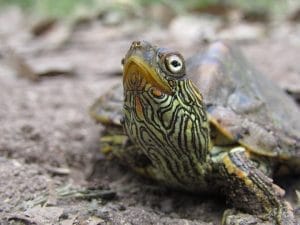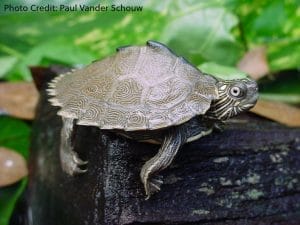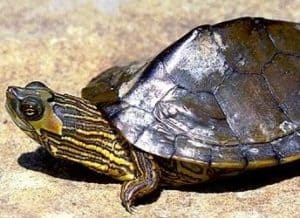Graptemys barbouri (Barbour’s Map Turtle)
Home > Turtle Database > Graptemys barbouri (Barbour’s Map Turtle)

Barbour’s Map Turtle (Graptemys barbouri) is a freshwater turtle species native to the southeastern United States. Named in honor of American herpetologist Thomas Barbour, this turtle is recognized for its distinctively patterned shell and the prominent spines along its back, resembling a topographic map.
Native Turtle Species Map – Find Turtles by Region
Scientific Classification
- Kingdom: Animalia
- Phylum: Chordata
- Class: Reptilia
- Order: Testudines
- Family: Emydidae
- Genus: Graptemys
- Species: Graptemys barbouri
Common Names
- Barbour’s Map Turtle
- Barbour’s Sawback Turtle
This Hilarious Turtle Book Might Know Your Pet Better Than You Do
Let’s be real—most turtle care guides feel like reading a textbook written by a sleep-deprived zookeeper.
This one’s not that.
Told from the snarky point of view of a grumpy, judgmental turtle, 21 Turtle Truths You’ll Never Read in a Care Guide is packed with sarcasm, sass, and surprisingly useful insights.
And hey—you don’t have to commit to the whole thing just yet.
Grab 2 free truths from the ebook and get a taste of what your turtle really thinks about your setup, your food choices, and that weird plastic palm tree.
It’s funny, it’s honest, and if you’ve ever owned a turtle who glares at you like you’re the problem—you’ll feel seen.
Identification
Description
Barbour’s Map Turtle is a medium-sized turtle featuring a dark olive to brown carapace adorned with intricate yellowish markings that resemble a map. A prominent keel with spiny projections runs along the center of the shell. The plastron (underside) is lighter, typically yellow to cream-colored, with dark markings along the seams. The skin is dark with yellow to cream stripes on the neck, limbs, and head.
Sexual Dimorphism
There is significant sexual dimorphism in this species:
- Females: Larger, reaching up to 12 inches (30 cm) in shell length. They have broader heads and stronger jaws adapted for crushing hard-shelled prey like mollusks.
- Males: Smaller, averaging around 5 inches (13 cm) in shell length. They have narrower heads suited for softer prey.
Check more turtles from the Graptemys genus
Native Origin and Distribution
Geographical Range
Barbour’s Map Turtle is endemic to the Apalachicola River system, including the Chipola, Chattahoochee, and Flint rivers in:
- Florida
- Georgia
- Alabama
Preferred Habitat
This species thrives in large rivers with moderate to strong currents. They prefer:
- Clear waters with sandy or muddy bottoms
- Abundant basking sites like fallen logs and rocks
- Areas rich in aquatic vegetation and invertebrate life
Behavior
Feeding Habits
- Females: Primarily consume mollusks such as snails and clams, using their powerful jaws.
- Males and Juveniles: Have a more varied diet that includes insects, crayfish, and other small aquatic invertebrates.
Predators
- Eggs and Hatchlings: Vulnerable to raccoons, skunks, birds, and fish.
- Adults: Less prone to predation but can fall prey to large birds of prey and alligators.
Reproduction
Breeding Season
- Occurs from spring to early summer.
Reproductive Method
- Females lay multiple clutches per year, typically ranging from 5 to 10 eggs.
- Nests are constructed on sandy riverbanks above the flood line.
- Incubation Period: Approximately 60 to 75 days.
Conservation
Extinction Status
- IUCN Red List: Vulnerable
Threats
- Habitat Degradation: Pollution, dam construction, and alteration of waterways disrupt their natural habitats.
- Illegal Collection: Overharvesting for the pet trade poses a significant risk.
- Human Disturbance: Recreational activities can destroy nesting sites.
Conservation Measures
- Legal Protection: Regulations to prevent illegal collection.
- Habitat Conservation: Efforts to preserve and restore natural river habitats.
- Public Awareness: Educational programs highlighting the species’ ecological importance.
Economic Importance
While not of significant economic value, Barbour’s Map Turtle contributes to the ecological health of river systems. Their presence indicates a healthy ecosystem, which benefits local communities through:
- Biodiversity Conservation: Supporting a balanced aquatic environment.
- Ecotourism: Attracting wildlife enthusiasts and researchers.
Interesting Facts
- The species is named after Thomas Barbour, a notable American herpetologist.
- The map-like patterns on their shells are unique to each individual, much like a fingerprint.
- The pronounced spines on the shell’s keel tend to be more prominent in juveniles and males.
- Sexual dimorphism in this species is among the most extreme in North American turtles, particularly in head size and dietary habits.

About Author
Muntaseer Rahman started keeping pet turtles back in 2013. He also owns the largest Turtle & Tortoise Facebook community in Bangladesh. These days he is mostly active on Facebook.














